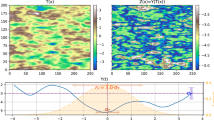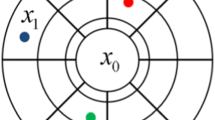Abstract
Joint geostatistical simulation techniques are used to quantify uncertainty for spatially correlated attributes, including mineral deposits, petroleum reservoirs, hydrogeological horizons, environmental contaminants. Existing joint simulation methods consider only second-order spatial statistics and Gaussian processes. Motivated by the presence of relatively large datasets for multiple correlated variables that typically are available from mineral deposits and the effects of complex spatial connectivity between grades on the subsequent use of simulated realizations, this paper presents a new approach for the joint high-order simulation of spatially correlated random fields. First, a vector random function is orthogonalized with a new decorrelation algorithm into independent factors using the so-termed diagonal domination condition of high-order cumulants. Each of the factors is then simulated independently using a high-order univariate simulation method on the basis of high-order spatial cumulants and Legendre polynomials. Finally, attributes of interest are reconstructed through the back-transformation of the simulated factors. In contrast to state-of-the-art methods, the decorrelation step of the proposed approach not only considers the covariance matrix, but also high-order statistics to obtain independent non-Gaussian factors. The intricacies of the application of the proposed method are shown with a dataset from a multi-element iron ore deposit. The application shows the reproduction of high-order spatial statistics of available data by the jointly simulated attributes.























Similar content being viewed by others
References
Almeida AS, Journel AG (1994) Joint simulation of multiple variables with a Markov-type co-regionalization. Math Geol 26(5):565–588
Arpat B, Caers J (2007) Stochastic simulation with patterns. Math Geosci 39:177–203
Bandarian E, Mueller U, Ferreira J, Richardson S (2010) Transformation methods for multivariate geostatistical simulation - minimum/maximum autocorrelation factors and alternating columns diagonal centres. In: Advances in Orebody Modelling and Strategic Mine Planning: Old and New Dimensions in a Changing World, The Australian Institute of Mining and Metallurgy, p 79–89
Barnett R, Manchuk JG, Deutsch CV (2014) Projection pursuit multivariate transform. Math Geosci 46(3):337–359
Boucher A, Dimitrakopoulos R (2008) Block simulation of multiple correlated variables. Math Geosci 41:215–237
Boucher A, Dimitrakopoulos R (2012) Multivariate block-support simulation of the Yandi iron ore deposit, Western Australia. Math Geosci 44:449–468
Boogaart KGvd, Tolosana-Delgado R, Lehmann M, Mueller U (2014) On the joint multipoint simulation of discrete and continuous geometallurgical parameters. In: Orebody Modelling and Strategic Mine Planning Symposium, Proceedings, Carlton. Australia, AusIMM, p 379–388
Boogaart KGvd, Mueller U, Tolosana-Delgado R (2016) An affine equivariant multivariate normal score transform for compositional data. Math Geosci, p 1–21. doi:10.1007/s11004-016-9645-y
Chatterjee S, Dimitrakopoulos R, Mustapha H (2012) Dimensional reduction of pattern-based simulation using wavelet analysis. Math Geosci 44:343–374
Chiles JP, Delfiner P (2012) Geostatistics: modeling spatial uncertainty, 2nd edn. Wiley, Hoboken
Chugunova TL, Hu LY (2008) Multiple-point simulations constrained by continuous auxiliary data. Math Geosci 40:133–146
Comon P (1994) Independent component analysis, a new concept? Signal Process 36:287–314
David M (1988) Handbook of applied advance geostatistical ore reserve estimation. Elsevier, Amsterdam
De Laco S, Maggio S (2011) Validation techniques for geological patterns simulations based on variogram and multiple-point statistics. Math Geosci 43:483–500
De Vries LM, Carrera J, Falivene O, Gratacós O, Slooten LJ (2008) Application of multiple point geostatistics to non-stationary images. Math Geosci 41:29–42
Desbarats AJ, Dimitrakopoulos R (2000) Geostatistical simulation of regionalized pore-size distributions using min/max autocorrelation factors. Math Geol 32:919–942
Dimitrakopoulos R (2011) Stochastic optimization for strategic mine planning: a decade of developments. J Min Sci 47:138–150
Dimitrakopoulos R, Fonseca M (2003) Assessing risk in grade-tonnage curves in a complex copper deposit, Northern Brazil, based on an efficient joint simulation of multiple correlated variables. In: Camisani-Calzolari FA (ed) 31st International Symposium on Application of Computers and Operations Research in the Minerals Industries, Cape Town, South Africa, 14–16 May 2003
Dimitrakopoulos R, Mustapha H, Gloaguen E (2010) High-order statistics of spatial random fields: exploring spatial cumulants for modeling complex non-Gaussian and non-linear phenomena. Math Geosci 42:65–99
Goodfellow R, Consuegra FA, Dimitrakopoulos R, Lloyd T (2012) Quantifying multi-element and volumetric uncertainty, Coleman McCreedy deposit, Ontario, Canada. Comput Geosci 42:71–78
Honarkhah M (2011) Stochastic simulation of patterns using distance-based pattern modeling. Ph.D. dissertation, Stanford University, Stanford, USA
Hyvärinen A (1999) Independent component analysis for time-dependent stochastic processes. ICANN 98 Perspectives in Neural Computing, p 135–140
Journel AG (2005) Beyond covariance: the advent of multiple-point geostatistics. In: Geostatistics Banff 2004. Springer, The Netherlands
Journel AG (2007) Roadblocks to the evaluation of ore reserves—the simulation overpass and putting more geology into numerical models of deposits. In: Orebody Modelling and Strategic Mine Planning Uncertainty and Risk Management, 2nd Edn. The AusIMM, Spectrum Series 14
Journel AG, Huijbregts C (1978) Min Geostat. Academic Press, New York
Kiers HAL (2000) Towards a standardized notation and terminology in multiway analysis. J Chemom 14:105–122
Lebedev NN (1965) Special functions and their applications. Prentice-Hall Inc., New York
Leuangthong O, Deutsch CV (2003) Stepwise conditional transformation for simulation of multiple variables. Math Geol 35:155–173
Li L, Srinivasan S, Zhou H, Gómez-Hernández JJ (2013) Simultaneous estimation of geologic and reservoir state variables within an ensemble-based multiple-point statistic framework. Math Geosci 46:597–623
Lochbühler T, Pirot G, Straubhaar J, Linde N (2013) Conditioning of multiple-point statistics facies simulations to tomographic images. Math Geosci 46:625–645
Maleki M, Emery X (2015) Joint simulation of grade and rock type in a stratabound copper deposit. Math Geosci 47:471–495
Mariethoz G, Renard P (2010) Reconstruction of incomplete data sets or images using direct sampling. Math Geosci 42:245–268
Mariethoz G, Renard P, Straubhaar J (2010) The direct sampling method to perform multiple-point geostatistical simulations. Water Resour Res 46
Morton J (2010) Scalable implicit symmetric tensor approximation, preprint. Pennsylvania State University, University Park
Morton J, Lim LH (2010) Principal cumulant components analysis, preprint. University of Chicago, Chicago
Mueller UA, Ferreira J (2012) The U-WEDGE transformation method for multivariate geostatistical simulation. Math Geosci 44:427–448
Mueller UA, Tolosana-Delgado R, van den Boogaart KG (2014) Approaches to the simulation of compositional data—a nickel-laterite comparative case study. In: Proceedings of Orebody Modelling and Strategic Mine Planning Symposium, AusIMM, Melbourne, p 61–72
Mustapha H, Chatterjee S, Dimitrakopoulos R (2013) CDFSIM: efficient stochastic simulation through decomposition of cumulative distribution functions of transformed spatial patterns. Math Geosci 46:95–123
Mustapha H, Dimitrakopoulos R (2010) High-order stochastic simulations for complex non-Gaussian and non-linear geological patterns. Math Geosci 42:455–473
Mustapha H, Dimitrakopoulos R, Chatterjee S (2011) Geologic heterogeneity representation using high-order spatial cumulants for subsurface flow and transport simulations. Water Resour Res 47(8). doi:10.1029/2010WR009515
Osterholt V, Dimitrakopoulos R (2007) Simulation of wireframes and geometric features with multiple-point techniques: application at Yandi iron ore deposit. In: Orebody modelling and strategic mine planning, 2nd edn. AusIMM, Spectrum Series, 14, p 95–124
Perry JM (1977) A class of conjugate gradient algorithms with a two-step variable-metric memory. Center for Mathematical Studies in Economics and Management Science, Northwestern University, Evanston (discussion paper 269)
Rezaee H, Mariethoz G, Koneshloo M, Asghari O (2013) Multiple-point geostatistical simulation using the bunch-pasting direct sampling method. Comput Geosci 54:293–308
Rondon O (2012) Teaching aid: minimum/maximum autocorrelation factors for joint simulation of attributes. Math Geosci 44:469–504
Rosenblatt M (1985) Stationary sequences and random fields. Birkhauser, Boston
Savas B, Lim LH (2009) Quasi-Newton methods on Grassmannians and multilinear approximations of tensors. SIAM J Sci Comput 32:3352–3393
Soares A (2001) Direct sequential simulation and co-simulation. Math Geol 33:911–926
Straubhaar J, Renard P, Mariethoz G, Froidevaux R, Besson O (2011) An improved parallel multiple-point algorithm using a list approach. Math Geosci 43:305–328
Strebelle S, Cavelius C (2013) Solving speed and memory issues in multiple-point statistics simulation program SNESIM. Math Geosci 46:171–186
Switzer P, Green AA (1984) Min/max autocorrelation factors for multivariate spatial imaging. Technical report no. 6, Department of Statistics, Stanford University
Tahmasebi P, Hezarkhani A, Sahimi M (2012) Multiple-point geostatistical modeling based on the cross-correlation functions. Comput Geosci 16:779–797
Toftaker H, Tjelmeland H (2013) Construction of binary multi-grid Markov random field prior models from training images. Math Geosci 45:383–409
Verly GW (1993) Sequential Gaussian co-simulation: a simulation method integrating several types of information. Quant Geol Geostat. In: Geostatistics Tróia 92, Springer, The Netherlands
Wackernagel H (1998) Principal component analysis for autocorrelated data: a geostatistical perspective. In: Technical report no. 22/98/G, Centre de Géostatistique, Ecole des Mines de Paris, Paris, France
Welling M (2005) Robust higher-order statistics. In: Proc. 10th Int Workshop Artif Intell Statist, p 405–412
Zhang T, Switzer P, Journel A (2006) Filter-based classification of training image patterns for spatial simulation. Math Geol 38:63–80
Zhang T (2015) MPS-driven digital rock modeling and upscaling. Math Geol 47:937–954
Acknowledgments
The work was funded from NSERC Collaborative Research and Development Grant CRDPJ 411270, entitled “Developing new global stochastic optimization and high-order stochastic models for optimizing mining complexes with uncertainty”, NSERC Discovery Grant 239019, and the COSMO consortium of mining companies (AngloGold Ashanti, Barrick Gold, BHP Billiton, De Beers, Kinross Gold, Newmont Mining and Vale).
Author information
Authors and Affiliations
Corresponding author
Appendix: Statistics and Simulation Results
Appendix: Statistics and Simulation Results
The histograms of alumina, phosphorus, and LOI contents are shown in Figs. 23, 24, and 25, respectively. The scatter plots for Fe–SiO\(_{\mathrm {2 }}\) and SiO\(_{\mathrm {2}}\)–Al\(_{\mathrm {2}}\)O\(_{\mathrm {3}}\) are shown in Figs. 26 and 27, respectively. In Figs. 28, 29 and 30 simulation results for alumina, phosphorus, and LOI contents are shown.
Rights and permissions
About this article
Cite this article
Minniakhmetov, I., Dimitrakopoulos, R. Joint High-Order Simulation of Spatially Correlated Variables Using High-Order Spatial Statistics. Math Geosci 49, 39–66 (2017). https://doi.org/10.1007/s11004-016-9662-x
Received:
Accepted:
Published:
Issue Date:
DOI: https://doi.org/10.1007/s11004-016-9662-x











